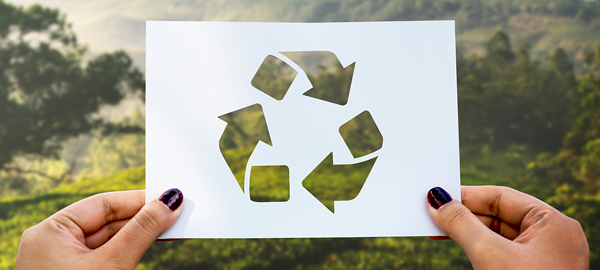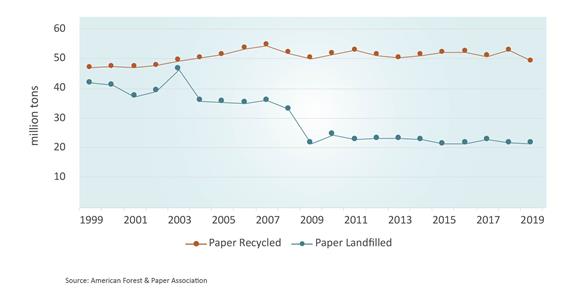
The amount of paper going into landfills is estimated to have declined significantly over the past 10 years, from about 33 million tons in 2008 to approximately 21.3 million tons in 2018 (the last year for which the American Forest and Paper Association has data). The decline in landfill was partly attributable to a rise in the paper recovery rate, which hit a historic high of 68.1% in 2018. In addition to recycling, some paper is diverted from landfills because it is disposed of in other ways such as via incineration with energy recovery or, in the case of bathroom tissue, via the sewer system.
In comparison with previous years, the recovery rate is the highest on record, which dates back to 1990. The next-highest year was 2016 when the U.S. notched 67.2%. The rate has generally trended upwards, with occasional backslides, such as in 2012, 2013, and 2017 (these years coincided with market challenges spurred by Chinese import restrictions, first with Green Fence and later with National Sword).
“It looks like robust demand to me,” said Brian Hawkinson, executive director of recovered fiber for AF&PA, in an interview with Resource Recycling. Domestic mill consumption of recovered fiber grew by 2.7% and exports grew by 4.2%, according to AF&PA.“Mills are using more recovered fiber as a raw material to make paper and paper-based packaging in the U.S.,” Hawkinson said.
There are a multitude of factors that will influence the recovery rate to increase in the future. Additionally, there are many actors in the recycling chain, each one of which must have a positive value proposition to participate. Technological advances in product design and recycling systems, the economics of paper and fiber, and social practices are some of the more important determinants to the future recovery rate.
Paper recovery success is largely attributed to the voluntary, market-driven product recovery system that many in the U.S. have fostered. The recovery rate for paper consumed in the U.S. has nearly doubled since 1990. The recycling rate for paper and paper-based packaging remains strong, meeting or exceeding 63% every year since 2009.

| Paper Recycled (million tons) |
Paper Landfilled (million tons) |
|
| 1993 | 35.5 | 37.8 |
| 1994 | 39.7 | 38.0 |
| 1995 | 42.2 | 36.4 |
| 1996 | 43.1 | 34.6 |
| 1997 | 44.0 | 37.3 |
| 1998 | 45.1 | 38.3 |
| 1999 | 46.8 | 41.7 |
| 2000 | 47.3 | 41.1 |
| 2001 | 47.0 | 37.2 |
| 2002 | 47.6 | 39.1 |
| 2003 | 49.3 | 46.4 |
| 2004 | 50.2 | 35.7 |
| 2005 | 51.3 | 35.4 |
| 2006 | 53.3 | 34.9 |
| 2007 | 54.3 | 36.0 |
| 2008 | 51.8 | 33.0 |
| 2009 | 50.0 | 21.4 |
| 2010 | 51.5 | 24.3 |
| 2011 | 52.8 | 22.7 |
| 2012 | 51.1 | 23.1 |
| 2013 | 50.1 | 23.2 |
| 2014 | 51.2 | 22.6 |
| 2015 | 52.0 | 21.3 |
| 2016 | 52.2 | 21.4 |
| 2017 |
50.8 | 22.7 |
| 2018 | 52.7 | 21.7 |
| 2019 | 49.2 | 21.5 |
AF&PA’s “Paper Industry Annual Statistical Summary” for Paper Recovered


